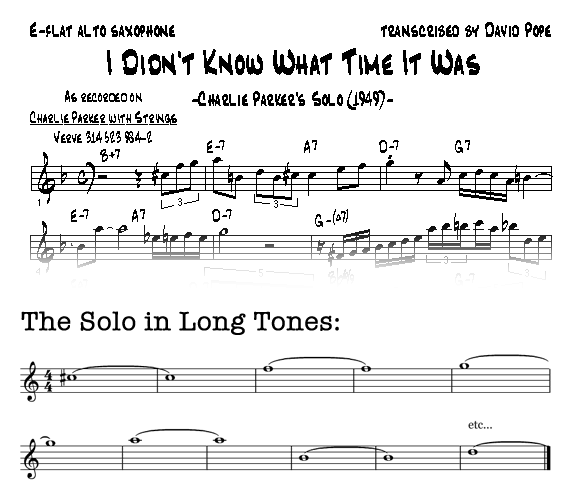How to Make Your Long Tone Practice Bearable, and Even…Fun?

Yes, I know, they’re not as fun as learning that hip new Mark Turner lick or wailing over Jamey Aebersold. But they’re necessary. The “they’re” I’m referring to are, of course, our dreaded long tones.
But the truth is, they don’t have to be so torturous. There’s things you can do to make them more fun. There’s no rule that says they have to be chromatic, absent-minded dirges.
Here are some ideas to help you rekindle the fire in your own long tone practice (and make sure to use a metronome!):
1) Practice Moving Between Different Intervals
Instead of playing your long tones in a series of half steps (Bb-B-C-C#-D etc), how about playing them in other intervals? What about, for example, a series of major 6ths? (see example below)
For bigger intervals such as 5ths, 6ths and 7ths, play as far up the register of the horn as you can manage, dropping down to the lower octaves as needed. If you’re new to the concept of intervals, you can get the lowdown at good ole’ Wikipedia.

2) Use a Tune or a Transcribed Solo
Why not practice playing a tune, or even better yet, a transcribed solo with every note lasting for 8 counts? I say that transcribed solos are preferable since they have less repeated notes, and less repetitive long tones equals less painful long tones. Here’s an example of what I’m talking about:

3) Improvise Your Own Long Tone Solo
And don’t think that you have to be a jazz cat to do this. Anyone can improvise. Just use your ear, and play along to whatever you hear come into your head spontaneously. I know, easier said than done, but when you’re doing it at a super-slow tempo, the link between brain and horn gets a lot tighter. So just make something up, anything at all, as long as every note lasts at least 4 slow counts. And for you jazzfolk out there, how about doing a slow blues, one note, one measure at a time? Any song form will do, of course. Talk about saving two birds with one bird-first aid kit! (I hate the thought of killing two birds with a stone, don’t you?).
4) Try to Match Overtone Versions of Notes
This is a classic exercise that many of us don’t practice enough. All we’re doing here is fingering the note with the alternate overtone fingering for 4-8 counts, and then go to the normal fingering for another 4-8 counts. Naturally, the overtone version of the note is going to sound noticeably bigger and louder, but the goal will be to get the normal fingering of the note to sound as full and rich as the overtone version. For more info on overtones, hop over here.
5) Play in Odd Meters
So much of modern music is written in time signatures other than our beloved 4/4 and 3/4. And there are very few of us who couldn’t benefit from getting used to feeling time in meters that we’ve avoided for far too long. Counting 7 slow quarter notes instead of the usual 8 may not seem like much, but once those 7 beats become intuitive to you, then you’ve put yourself firmly on the path to more rhythmic freedom – improving your tone all the while.
6) Play long tones in unison with something or someone else
In a recent newsletter, I spoke about the value of playing along with others, in part, for the sake of improving your powers of intonation. So if you can, grab a buddy (well, don’t actually grab them, but you know what I mean) and start playing long tones in unison. Try to match each other not only in pitch, but also in areas such as timbre (ie: the color of your sound), dynamics (crescendos and decrescendos), vibrato, any other aspect of your long tone playing that you can synchronize. Don’t have a buddy to practice with? See if you can get yourself some sort of a sound source to practice along with. There’s a popular tool out there known as The Tuning C.D. that you can play along with. Or you can check out the article on this site that explains how to create your own long tone play-along, and even offers an mp3 for those without the ability (or the time) to record their own long-tone exercise.
7) Try Varying Your Dynamics
One common technique is to start each long tone very softly at pianissimo and then work your way up as loud as possible to fortissimo and then back down to silence. But what if you tried to mix things up? You could reverse the technique I just mentioned, starting loud, then getting soft. Or you could do a crescendos over 2 beats and a decrescendo over the next 2 beats. Lots of possibilities here. The nice thing is that this type of practice will really put your embouchure to the test, as it’s very common to tighten up as you get louder, so if you can keep the embouchure in place regardless of your volume, then you will have given yourself a powerful and practical workout.
So There You Have It
There are just a few ideas. The moral of the story here is that with a bit of creativity, you can find an endless variety of ways to practice long tones, and, in effect, “trick yourself” into enjoying and benefitting from this crucial, but oftentimes painfully boring task.






November 14, 2012 @ 6:36 pm
gee, nobody told me longtones were supposed to be boring! I always assumed they were part of the vibrational foundation Om of the Universe and I just chimed in! :)
November 14, 2012 @ 6:54 pm
I KNEW I left one suggestion out of my list – glad you spoke up, Gary!
November 17, 2012 @ 9:17 am
Great suggestions, as usual, Doron. For me, long tones are a sort of meditation, helping me to connect to how I hear and produce my sound. I typically encourage my students to use long tones as an activity in which they can pay attention to what they are doing with themselves as they play. I’ll have them mentally themselves questions such as, “Where am I working too hard?”, “Am I stiffening my neck and shoulders as I play?”, “Are my knees locked?”, “Is my jaw free?”, “How is my breathing?”, etc. I suggest they do this as they notice the quality of their sound. This establishes a firm relationship between the quality of their efforts and the sonic results that follow. Thinking this way when doing long tones is a very effective way to learn how to become aware of and direct themselves to stay in control when the notes really get flying. It works wonders.
Also, I especially like your idea of using particular interval patterns for long tones. The benefits of this kind of practice are many. One of the things I have my beginning improvisation students do is play long tones organized around the circle of 5ths. This helps establish both the aural and the cognitive skills necessary to work with this very important sequence. They quickly learn to recognize, hear and think ii-V-I progressions. Thanks again for a great article!
November 17, 2012 @ 10:58 am
Bill, I love how your comments always make for articles in themselves. It seems like what you are getting at is that gaining an overall awareness of one’s body and releasing tension are absolutely key to great playing. And I’ve seen this in action with my own playing. 15 minutes of conscious practice can be better than 2 hours of going through the motions.
So thanks for the great suggestions as well as the kind words!
December 14, 2012 @ 8:32 am
I really like doing long tone exercises with a drone of some sort. This way I not only work on my tuning, but hear valuable relationships between intervals while I practice. There are a few good apps that create drones, or something called the Tuning CD that I’m quite fond of too.
December 16, 2012 @ 8:35 pm
Wow, never thought of the whole intervallic hearing aspect of practicing with a drone. Seems like a great way to work on perfecting one’s relative pitch. Thanks Sam!